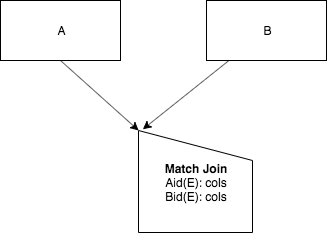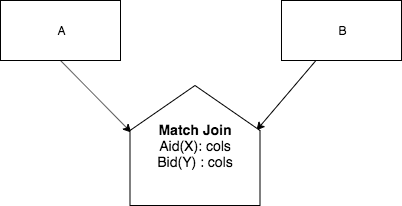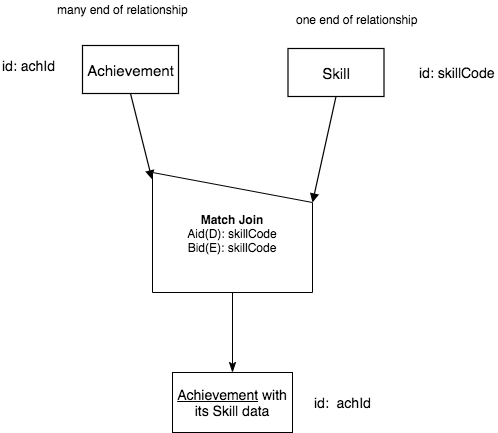13.2. Circumstances For Match Joins¶
There are three aspects of completing a Match Join that you need to think about. These three aspects make up a particular circumstance of Match Join.
Aspect 1: What Bases?
First, you must know what the bases of the input relations A and B are and which category they fall into, which is one of the following 3.
A, B have Different Bases
A, B have the Same Base
A, B are the Same Relation
Aspect 2: Symmetry
Second, you need to understand the symmetry of the Match Join you are attempting. This can be done by considering the columns that you are choosing to match over and which of these is happening:
M - 1 from A to B: for a row in A, when you match over the column, there is one row in B. The matching column’s value can occur many times in A. There is a direct correspondence between this and a Many-to-One relationship when using relations from your original database, such as from Achievement to Skill.
1 - 1 from A to B: for a row in A, when you match over the column, there is one row in B. The matching column’s value occurs one time in A. There is a direct correspondence between this and a One-to-One relationship when using relations from your original database, such as from TeamSkill to Skill.
M - M from A to B: for a row in A, when you match over the column, there could be many rows from B. For a row in B, when you match over the column, there could be many rows in A. These cases occur most often from a chicken-feet-out shape from your original database.
The symmetry of the operator follows from these cases:
M - 1 indicates Non-Symmetric-A
1 - 1 indicates Symmetric-Either
M - M indicates Symmetric-Pair
Non-symmetric-A means that you should use the half-house and A should be the many end and go to the peak, and B should be the one end and go to the lower corner of the top, like this:

The M-1 non-symmetric case, where A is the many end and goes to the peak.¶
Symmetric-either indicates that you should use the half-house and A and B should go to the peak (recall this was the case for Union and Intersect also). For Match Join, it looks like this:

The 1-1 symmetric-either case.¶
Symmetric-Pair indicates that you should use the full house symbol and A and B should go to either side on the lower corners of the ‘roof’, like this:

The M-M symmetric-pair case.¶
We will see an example of M - M Symmetric Pair shortly.
Aspect 3: Works-on Columns
Third, you should know the nature of the columns from the inputs, A and B, that are being matched. As discussed in the previous section, we must be aware of how the matching columns relate to the identifying columns. This is shown in the following table.
Letter |
Short Name |
Input relation’s columns being matched |
|---|---|---|
E |
Exactly |
exactly its id (all identifying columns) |
M |
More |
more than its id (id +) |
S |
Some |
some of its id columns, but not all (fewer) |
O |
Overlapping |
some of its id columns, + some non-id columns |
D |
Disjoint |
disjoint from id columns (no id columns) |
Important
Inside the operator we use the tags Aid(X): and Bid(Y): before the list of columns to be matched, where X and Y are one of the above letters, E, M, S, O, D. For example, Aid(D) indicates that the columns listed are not A’s identifying columns (disjoint), and Bid(E) means that exactly all of B’s identifying columns will be matched. Here is the example from the previous section again, illustrating this:

Recall that the relationship from Achievement to Skill is many-1 and that skillCode is exactly Skill’s identifying columns (Skill is relation B in this binary Match Join operator). Achievement’s identifier is an arbitrary column called achId, so when we match on skillCode data values between Achievement and Skill on this column, we will be matching on a column that is disjoint from Achievement’s identifier.
13.2.1. How to consider the Symmetry Aspect¶
Let’s consider the above important notion further with a different example. This is the data in the 2 relations named Creature and Skill.
creatureId |
creatureName |
creatureType |
reside_townId |
idol_creatureId |
|---|---|---|---|---|
1 |
Bannon |
person |
p |
10 |
2 |
Myers |
person |
a |
9 |
3 |
Neff |
person |
be |
NULL |
4 |
Neff |
person |
b |
3 |
5 |
Mieska |
person |
d |
10 |
6 |
Carlis |
person |
p |
9 |
7 |
Kermit |
frog |
g |
8 |
8 |
Godzilla |
monster |
t |
6 |
9 |
Thor |
superhero |
as |
NULL |
10 |
Elastigirl |
superhero |
mv |
13 |
11 |
David Beckham |
person |
le |
9 |
12 |
Harry Kane |
person |
le |
11 |
13 |
Megan Rapinoe |
person |
sw |
10 |
skillCode |
skillDescription |
maxProficiency |
minProficiency |
origin_townId |
|---|---|---|---|---|
A |
float |
10 |
-1 |
b |
B2 |
2-crew bobsledding |
25 |
0 |
d |
C2 |
2-person canoeing |
12 |
1 |
t |
D3 |
Australasia debating |
10 |
1 |
NULL |
E |
swim |
5 |
0 |
b |
O |
sink |
10 |
-1 |
b |
PK |
soccer penalty kick |
10 |
1 |
le |
THR |
three-legged race |
10 |
0 |
g |
TR4 |
4x100 meter track relay |
100 |
0 |
be |
U |
walk on water |
5 |
1 |
d |
Z |
gargle |
5 |
1 |
a |
Suppose our goal is to Match Join Creature and Skill on the only column they have in common that can be matched: reside_townId and origin_townId. The difficult part of understanding the circumstance of this Match Join is deciding whether A’s relationship to B when doing the match of reside_townId and origin_townId is M-M, M-1, or 1-1.
What we want to know is these two things:
Is there at least one creature whose reside town is the origin town of more than one skill?
Is there an origin town of a Skill that is the reside town of more than one creature?
If both of these are true, then we have a M-M situation when matching over reside_townId of Creature and origin_townId of Skill. We can understand this by observing the data.
Try the query in the left tab below, which is a Times of Creature and Skill. Remember that Times is the basis of each Match Join. Look for the creature whose creatureId is 4 in the result, or to make it easier, add this to the query (simply so that we can zero in right now on a few rows):
where creatureId = 4
I’ve left a line for you to add this clause into the code. Don’t forget to leave the semi-colon (;) there.
When you add this restriction, count how many rows have reside_townId = origin_townId. You can verify this by changing the where clause again to this:
where creatureId = 4 and reside_townId = origin_townId
What you should see is that for the one Creature whose creatureId is 4, there is more than one Skill paired to it, because the Town whose skillCode is ‘b’, where this creature resides, is the origin town of more than one Skill.
Now let’s examine whether a particular Skill’s origin Town might be the reside Town of more than one creature. I’ll give you just what to look for- add this to the times portion of the SQL query, removing the where clause that you used before.
where reside_townId = 'le' and reside_townId = origin_townId
As you can see, the origin town of skill whose skillCode is ‘PK’ is the reside town of two creatures.
Now go to the second tab from the left to see the complete Match Join result, whose English query is:
Find each Creature - Skill Pair where the reside Town of the Creature is the same as the origin Town of the Skill.
Note
The second tab showing the match join is different in how we need to eliminate the duplicate column representing the exactly matching townId values from each relation. Study how we needed to explicitly write out the columns we want to take from Skill, and how we used a shortcut alias to name that relation as ‘S’.
Let’s review the circumstances of this example.
The two relations, Creature and Skill, each have a Different Base.
Through the common townId found in each relation, there are reside_townId values in Creature with many origin_townId values in Skill, and there are origin_townId values in Skill with many reside_townId values in Creature. This makes the connection between Creature and Skill through matching reside_townId to origin_townId a Many and Many, or M - M connection. We will use the full house symbol for this Match Join query.
Luckily, as we look at more cases in the following pages, you will begin to see how the conceptual schema provides you with enough information to decide whether A matched to B is M-1, 1-1, or M-M. Read on to see if you can discern how by studying the schema and the examples.
The works-on columns (those being matched through their data values, as given in the where clause in the SQL) are Aid(D): reside_townId and Bid(D): origin_townId.
After these decisions, the precedence chart for this example looks like this:

13.2.2. Recap¶
There are circumstances we must always consider when trying to use Match Join over a set of columns or one column between two input relations.
- Consider the bases of each of the two relations:
A, B have different bases
A, B have the same base
A, B are the same relation
- Determine the shape of the Match Join symbol to be used in the precedence chart by understanding the symmetry from A to B for the column(s) to be matched, or ‘worked on’:
M - 1 (non-symmetric, half house, many end at the peak, one end at the lower side)
1 - 1 (symmetric-either, half house, both arrows to the peak)
M - M (symmetric-pair, full house)
- For each of the two input relations, decide the nature of those columns to be ‘worked on’:
E, exactly the relation’s identifier (all identifying columns)
M, more than its identifier (id + at least one more column)
S, some of its id columns, but not all (fewer than its id columns)
O, overlap with some of its id column(s), but also additional column(s)
D, disjoint from its id columns (none of it id columns)
Important
It is important to keep in mind that the Match Join symbol, represented by different shapes depending on the symmetry conditions, is a replacement for a longer set of operators: Times followed by a filter using only equality, followed by a reduce or project. This helps you determine the SQL for the query after you have drawn the chart.
Becoming good at this and getting your queries right the first time can be done fairly easily if you use the above three steps to help you make decisions about the circumstances.
We will next outline the most common good circumstances that are used for Match Join, followed by examples of each one.